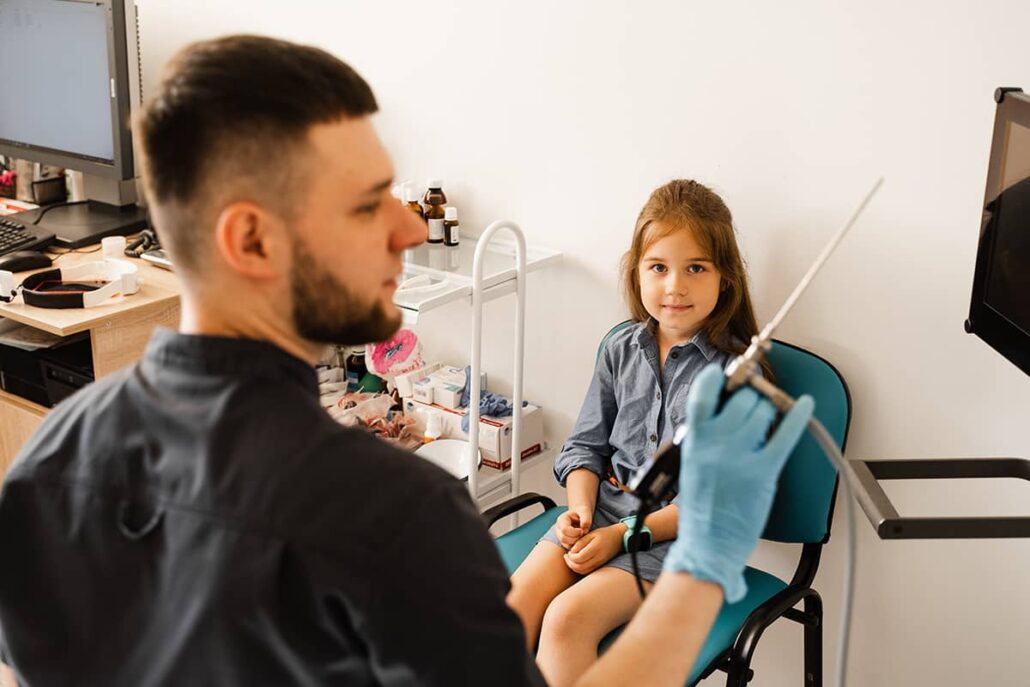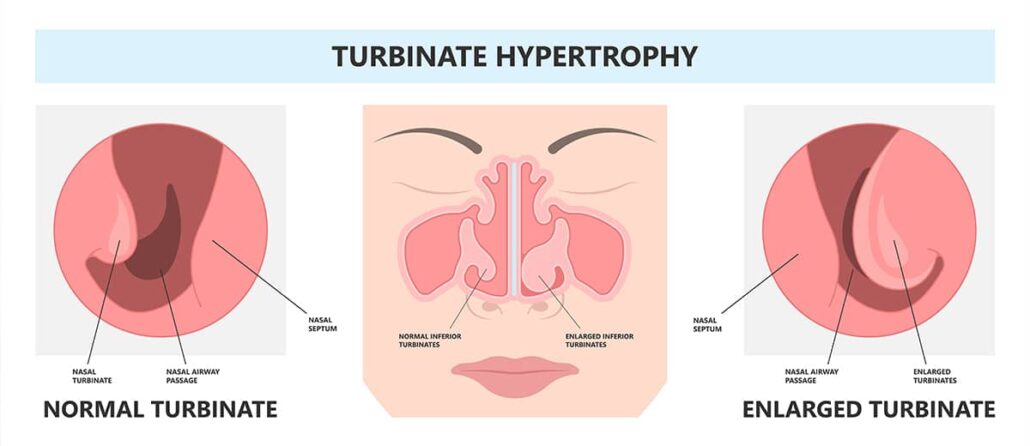Inferior turbinate hypertrophy is a condition in which the inferior turbinates in the nasal passage become enlarged, leading to obstructed breathing. This condition can affect children and may have a significant impact on their quality of life. Penn Medicine Becker ENT & Allergy’s experienced medical practitioners work closely with parents to ensure that their child receives treatment most suitable for their unique circumstances.
In this article, we will discuss the signs and symptoms of inferior turbinate hypertrophy in children, the diagnostic tests used to identify this condition, and the various treatment options available.

Signs and Symptoms of Inferior Turbinate Hypertrophy in Children
Symptoms of turbinate hypertrophy in children may vary, depending on the severity of the condition. Some of the most common signs and symptoms include:
- Nasal congestion or stuffiness: This is often the most noticeable symptom, as the enlarged turbinates obstruct the nasal airways, making it difficult for the child to breathe through their nose.
- Mouth breathing: Due to nasal obstruction, children with inferior turbinate hypertrophy may resort to breathing through their mouth, which can lead to dry mouth and other oral health issues.
- Snoring and sleep disturbances: The nasal obstruction caused by enlarged turbinates can lead to snoring and disrupted sleep, as the child struggles to maintain an open airway during sleep.
- Recurrent sinus infections: Enlarged turbinates can obstruct the normal drainage of mucus from the sinuses, increasing the risk of sinus infections.
- Nosebleeds: The increased pressure on the blood vessels within the turbinates may cause them to rupture, leading to nosebleeds.

These symptoms can also be indicative of other conditions, so a thorough evaluation by an Ear, Nose, and Throat specialist is necessary to ensure an accurate diagnosis. If your child exhibits these symptoms, consulting a child ENT doctor in Philadelphia can help ensure an accurate diagnosis and effective treatment plan tailored to their needs.
Diagnostic Tests for Inferior Turbinate Hypertrophy
If a child is experiencing symptoms suggestive of inferior turbinate hypertrophy, one or more of the following diagnostic tests might be used to confirm the diagnosis:
- Physical examination: The ENT will examine the child’s nasal passages, looking for signs of enlarged turbinates and other abnormalities that may be causing the symptoms.
- Nasal endoscopy: This procedure involves inserting a thin, flexible tube with a light and camera at the end (endoscope) into the child’s nose to visualize the nasal passages and turbinates. This will help to assess the size of the turbinates and identify any other issues that may be contributing to the nasal obstruction.
- Imaging studies: In some cases, imaging, such as X-rays or computed tomography (CT) scans, will be used to further evaluate the nasal passages and surrounding structures.
- Allergy testing: Allergy testing may be performed to determine if allergies are playing a role in the child’s symptoms.
Once the appropriate diagnostic tests have been conducted, your ENT will determine the most suitable treatment approach for the child’s specific condition.
Treatment Options for Inferior Turbinate Hypertrophy in Kids
There are several treatment options available for children with inferior turbinate hypertrophy, ranging from conservative management to surgical interventions. Some of the most common treatment options include:
- Nasal saline irrigation: Regular use of nasal saline sprays or rinses can help to keep the nasal passages moist and reduce congestion.
- Allergy management: If allergies are contributing to the child’s symptoms, appropriate allergy treatments, such as antihistamines, corticosteroid nasal sprays, or immunotherapy may be recommended.
- Medication: Decongestants, antihistamines, and corticosteroid nasal sprays can help to reduce nasal congestion and inflammation, providing temporary relief from symptoms. See below for details about these medicines.
- Surgical intervention: In cases where traditional treatments are not effective, or the child’s quality of life is significantly impacted, surgical procedures such as turbinate reduction or a different procedure may be considered.
The choice of treatment depends on an accurate diagnosis and the severity of the condition. Penn Medicine Becker ENT & Allergy can determine the appropriate treatment plan for your child’s specific needs.

Role of Environmental Factors in the Development of Inferior Turbinate Hypertrophy
Environmental factors can play a significant role in the development and exacerbation of inferior turbinate hypertrophy in children. Some common environmental factors that may contribute to this condition include:
- Allergens: Exposure to allergens such as pollen, dust mites, mold, and pet dander can cause inflammation and swelling of the nasal passages, leading to turbinate hypertrophy.
- Irritants: Irritants such as cigarette smoke, air pollution, and perfumes can also trigger nasal inflammation and contribute to the development of inferior turbinate hypertrophy.
- Dry air: Living in a dry environment or using heating systems that reduce indoor humidity can cause the nasal passages to become dry and irritated, leading to turbinate swelling.
By identifying and addressing these environmental factors, it may be possible to reduce the severity of inferior turbinate hypertrophy symptoms and improve the child’s well-being.
Complications of Untreated Inferior Turbinate Hypertrophy in Children
If left untreated, inferior turbinate hypertrophy can lead to several complications that may impact a child’s health and well-being. Some of the potential complications include:
- Chronic sinusitis: Persistent nasal obstruction can lead to poor sinus drainage, increasing the risk of chronic sinus infections.
- Sleep apnea: Severe nasal obstruction can cause sleep apnea, a condition where breathing is repeatedly interrupted during sleep, leading to poor sleep quality and other health issues.
- Impact on facial growth: Prolonged mouth breathing due to nasal obstruction can affect the normal growth and development of the facial bones and dental arches, leading to orthodontic problems and changes in facial appearance.
- Impaired quality of life: The ongoing symptoms of inferior turbinate hypertrophy, such as nasal congestion, snoring, and sleep disturbances, can significantly impact a child’s quality of life, including their ability to concentrate, perform well in school, and engage in social activities.
Early diagnosis and appropriate treatment of inferior turbinate hypertrophy can help to prevent these complications and ensure that children receive the care they need to maintain optimal health.
Lifestyle Changes that Help Treat Inferior Turbinate Hypertrophy
In addition to medical treatments, certain lifestyle changes can help alleviate the symptoms of inferior turbinate hypertrophy in children. These changes may include:
- Allergen reduction: Minimizing exposure to allergens such as pollen, dust mites, mold, and pet dander can help reduce nasal inflammation and congestion.
- Humidification: Using a humidifier in the child’s bedroom can help maintain optimal humidity levels, reducing nasal dryness and irritation.
- Air filtration: Installing high-efficiency air filters in the home can help remove airborne allergens and irritants, improving indoor air quality and reducing inflammation.
- Smoking cessation: Encouraging family members to quit smoking or avoid smoking indoors can help reduce the child’s exposure to secondhand smoke, a known irritant that can contribute to nasal inflammation.
Implementing these lifestyle changes in conjunction with medical treatments can help improve the child’s overall quality of life and reduce the severity of nasal turbinate hypertrophy symptoms.
Medication Treatments for Inferior Turbinate Hypertrophy
Medication treatments can be an effective way to manage symptoms of inferior turbinate hypertrophy. These treatments aim to reduce nasal congestion and inflammation, providing temporary relief:
- Decongestants: Decongestants can help to relieve nasal congestion by narrowing the blood vessels in the nasal passages. They are available in oral and nasal spray forms. However, it is important to use them only for short periods, as long-term use may lead to a worsening of symptoms.
- Antihistamines: Antihistamines are used to manage allergy symptoms, including nasal congestion and inflammation. They work by blocking the effects of histamine, a chemical released by the immune system during an allergic reaction. Antihistamines can be taken orally or used as nasal sprays.
- Corticosteroid nasal sprays: These sprays can help to reduce inflammation in the nasal passages, providing relief from congestion and other symptoms. They are typically used for the long-term management of chronic nasal inflammation and may take up to two weeks to provide noticeable relief.
If allergies are found to be contributing to a child’s symptoms, these medications will also help to manage them, or immunotherapy may be recommended.
Medication treatments should be tailored to each child’s specific needs and medical history. An experienced ENT specialist can help determine the most appropriate medication treatment plan for a child with inferior turbinate hypertrophy.
Surgeries to Correct Inferior Turbinate Hypertrophy
In cases where conventional treatments and medications are not effective in managing the symptoms of inferior turbinate hypertrophy, surgical interventions may be considered. Some common surgical procedures for this condition include:
- Turbinate reduction Surgery: This procedure involves reducing the size of the inferior nasal turbinates, either through the removal of tissue or by shrinking the tissue using radiofrequency ablation or other techniques. This can help improve airflow and reduce nasal congestion.
- Adenoidectomy: This surgery involves the removal of the adenoids, which are lymphoid tissues located at the back of the nasal cavity. Enlarged adenoids can contribute to nasal obstruction and may be removed to improve breathing and reduce the risk of chronic sinus infections.
- Septoplasty: In some cases, a deviated nasal septum may be contributing to nasal obstruction. A septoplasty is a surgical procedure that corrects the alignment of the nasal septum, improving airflow and reducing congestion.
If you or your child are suffering from the symptoms of inferior turbinate hypertrophy, seek medical attention and professional advice from Becker ENT & Allergy. A team of experienced professionals will help you diagnose and treat this condition with a combination of lifestyle changes, medications, and if necessary, surgeries.
However, surgical interventions should only be considered after a thorough evaluation by a qualified pediatric ENT. By working closely with the experienced physicians at Penn Medicine Becker ENT & Allergy, parents can ensure that their child receives the most effective treatment for their specific needs.

